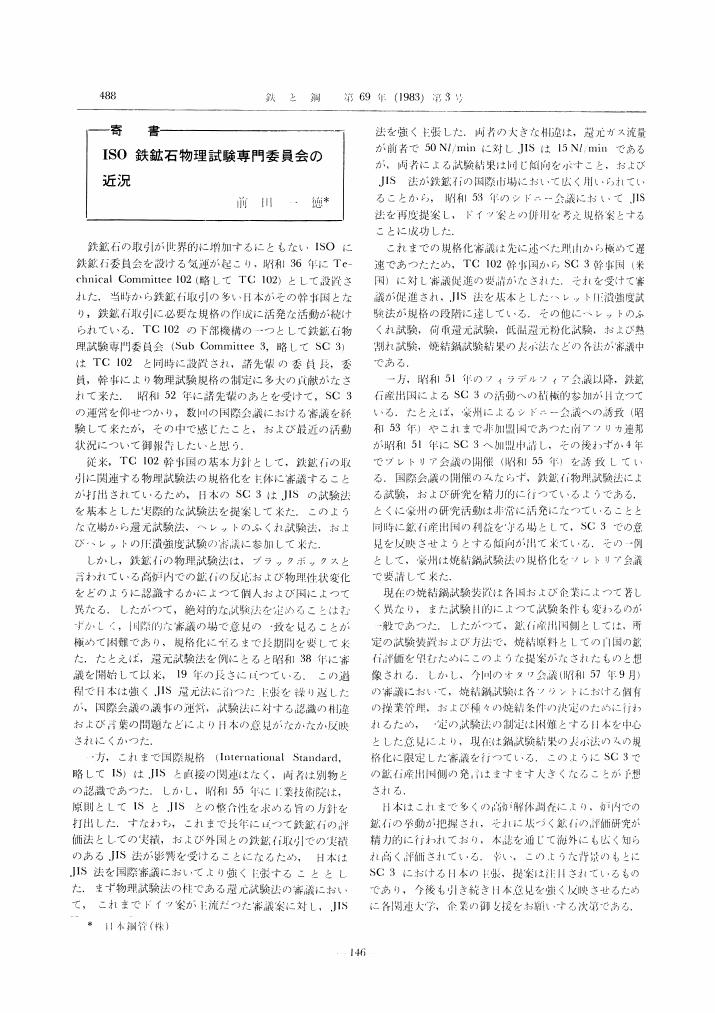2 0 0 0 OA 性質
2 0 0 0 OA 電氣熔接用高張力鋼板の試作研究
- 著者
- 堀川 一男
- 出版者
- 社団法人日本鉄鋼協会
- 雑誌
- 鐵と鋼 : 日本鐡鋼協會々誌 (ISSN:00211575)
- 巻号頁・発行日
- vol.39, no.7, pp.705-715, 1953-07-25
As a high-tensile steel sheet for ship-building a Mn bearing low alloy steel like DS was hitherto used, but since electric arc welding became widely applied for the purpose of saving weight and labor, high tensile steel of superior weldability has been in demand. This study was made by the Japanese Navy technical staffs during the World War II. Eleven kinds of steel regarded as being suitable for welding were selected with reference to the Japanese and foreign technical literatures. Thirteen kinds of steel in all including DS and HT selected for comparison with these steels were melted with a high frequency furnace and then rolled into sheets of 12mm width. The mechanical properties, weldability and strength of butt-welded joint of these experimentally manufactured steel sheets were tested. As a result of tests, it was confirmed that DS and HT hitherto used had quite inferior weldability, while Si-Mn steel showed the most excellent properties. In view of the test results and from the standpoint of mass production and domestic natural resources, the standard of the components of steel experimetally manufactured by an O.H. furnace was determined as follows : C 0.15∿0.20%, Si 0.3∿0.7% and Mn 0.9∿1.2%. Eight charges were melted, poured into 6∿18t ingots and rolled into 12∿22 mm wide sheets in the Kure Naval Arsenal and Yawata Iron Works. Several types were performed on these experimentally manufactured sheets, and they showed generally satisfactory results. Mechanical properties of these sheets were as follows : Yield point 32∿43 kg/mm^2, tensile strength 52∿60 kg/mm^2, elongation 23∿32% (G.L.=200 mm) Trial use of these sheets for construction of submarines with an application of welding showed excellent results without causing any defects.
1 0 0 0 OA 高張力鋼の歴史
- 著者
- 堀川 一男
- 出版者
- 安全工学会
- 雑誌
- 安全工学 (ISSN:05704480)
- 巻号頁・発行日
- vol.15, no.1, pp.1-7, 1976-02-15 (Released:2018-06-30)
欧米で軟鋼が大量に生産されるようになったのは1860年頃であるが,軟鋼の出現により陸上・海上のあらゆる構造物に使用されるようになった.しかし,産業の進歩発展に伴って各種の鉄鋼構造物は大型化,大容量化の傾向が強まり,軟鋼を用いたのでは部材の断面が課題となり構造上,構築上種々の困難が出てきた.そこで開発されたのが高張力鋼である.戦前は鋲,ボルトで接合していたが戦後は溶接継手が主力になったので,溶接に適した強度の高い鋼が生産されるようになり,特殊用途用にも各種の鋼が出現した.
1 0 0 0 旧陸海軍鉄鋼技術調査委員会, 調査活動を終わる
- 著者
- 堀川 一男
- 出版者
- 社団法人日本鉄鋼協会
- 雑誌
- 鐵と鋼 : 日本鐡鋼協會々誌 (ISSN:00211575)
- 巻号頁・発行日
- vol.77, no.6, pp.N287-N289, 1991-06-01
1 0 0 0 OA 第97回講演大会討論会講演概要
- 著者
- 堀川 一男
- 出版者
- 一般社団法人 日本鉄鋼協会
- 雑誌
- 鉄と鋼 (ISSN:00211575)
- 巻号頁・発行日
- vol.65, no.2, pp.A61-A84, 1979-02-01 (Released:2010-02-22)
- 被引用文献数
- 1 1
1 0 0 0 OA ISO鉄鉱石物理試験専門委員会の近況/第二次世界大戦中における製鋼技術の開発研究
- 著者
- 前田 一徳 堀川 一男
- 出版者
- 一般社団法人 日本鉄鋼協会
- 雑誌
- 鉄と鋼 (ISSN:00211575)
- 巻号頁・発行日
- vol.69, no.3, pp.488-491, 1983-03-01 (Released:2009-06-30)
1 0 0 0 OA 大型特殊鋼材の軟化焼鈍への等温變態の應用 I
- 著者
- 堀川 一男
- 出版者
- 社団法人日本鉄鋼協会
- 雑誌
- 鐵と鋼 : 日本鐡鋼協會々誌 (ISSN:00211575)
- 巻号頁・発行日
- vol.35, no.10, pp.355-359, 1949-10-25
The purpose of this study was to save fuels, equipments and labours reguired for full annealing of low alloy steel thick forgings. In this first report, theory of isothermal annealing and fundamental studies carried out on small spacimens were given. The steel used was a medium C low Ni-Cr-Cu-Mo steel contg. 0.30∿0.35%C, 0.6∿1.0%Mn, 1.0∿1.8%Ni, 1.0∿1.3%Cr, 0.2∿0.4%Cu and 0.4%Mo. To determine the S-curve of this steel, thermal expansion was measured and microstructure and hardness of specimens quenched after isothermal heating were investigated. The results obtained were summarized as follows : (1) This steel can be full annealed within 5 hrs. if its supercooled austenitic state is kept and transformed at 660∿670℃, 6 hrs. at 650∿680℃ and 9 hrs. at 640℃ (2) The isothermally annealed steel is satisfactorily softened and its Brinnel hardness number is below 200. (3) The microstructure of the isothermally annealed steel is quite different from that of the ordinary annealing, but the time required for heating in the quenching operation those steels was not varied between these two different annealing structures. (4) That different annealing process has no influence on the mechanical properties of the steel after hardening and tempering.




